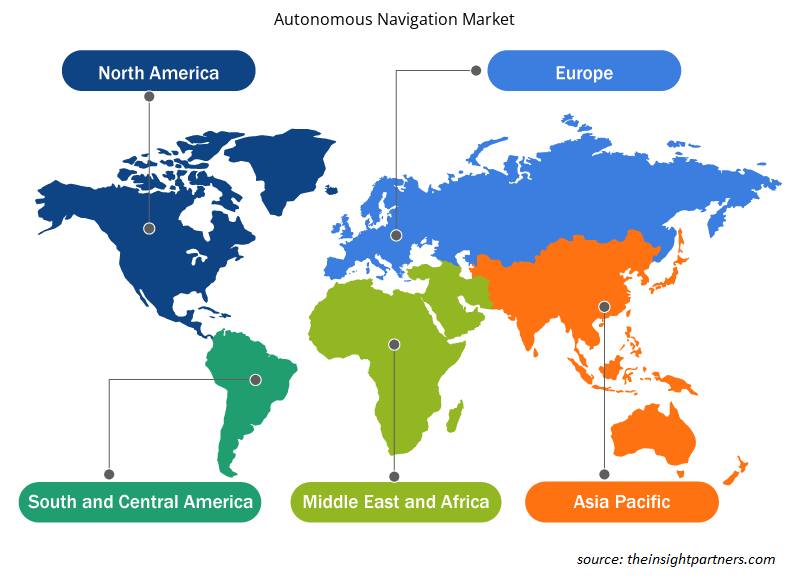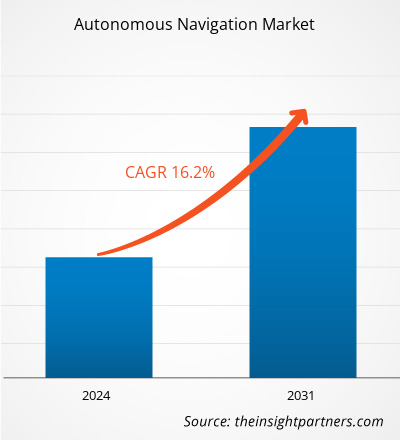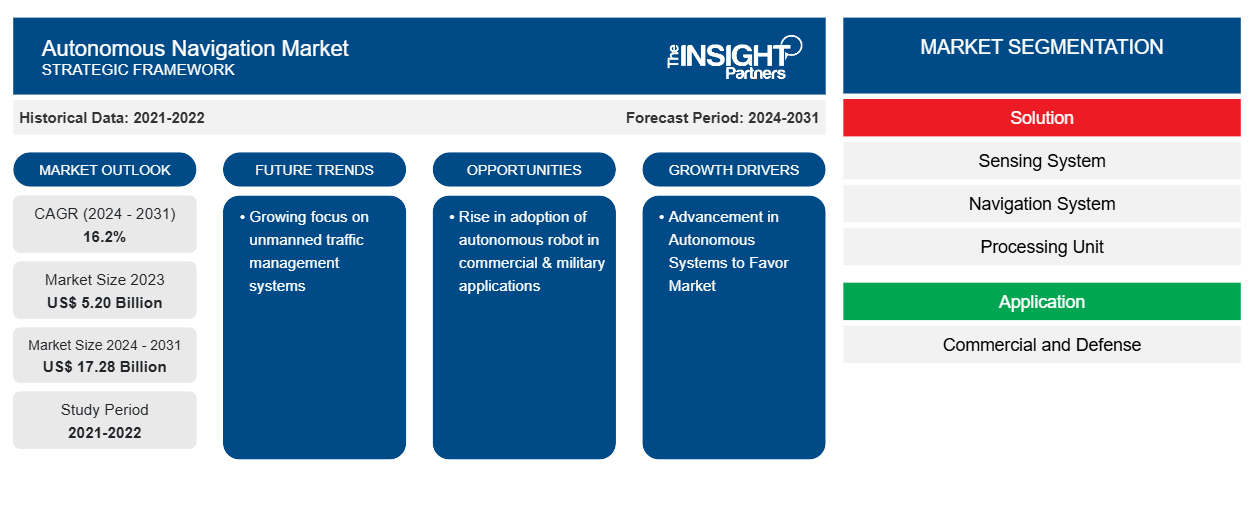Se espera que el tamaño del mercado mundial de navegación autónoma crezca de 5.200 millones de dólares en 2023 a 17.280 millones de dólares en 2031; se anticipa que se expandirá a una CAGR del 16,2% entre 2024 y 2031. Es probable que el enfoque creciente en los sistemas de gestión de tráfico no tripulados siga siendo una tendencia clave del mercado de navegación autónoma.
Análisis del mercado de la navegación autónoma
Los continuos intentos de avanzar en el campo de los sistemas autónomos han sido un factor decisivo en el sector de la navegación autónoma. El desarrollo de sistemas avanzados de navegación autónoma para diversas plataformas, como las aéreas, terrestres, marinas y espaciales, ha ayudado a impulsar la expansión del mercado.
Panorama del mercado de la navegación autónoma
Un sistema de navegación autónomo es una tecnología compleja que permite a vehículos como drones, robots, automóviles y barcos planificar y ejecutar sus itinerarios sin necesidad de interacción humana. Este sistema utiliza una combinación de tecnologías complicadas, entre las que se incluyen navegación inercial, navegación por satélite, radares, cámaras, navegación ultrasónica y acústica , así como algoritmos potentes, para realizar juicios inteligentes en función del entorno circundante. Utilizando estas tecnologías de vanguardia, el sistema de navegación autónomo garantiza que los automóviles naveguen de forma precisa y segura.
Personalice este informe según sus necesidades
Obtendrá personalización en cualquier informe, sin cargo, incluidas partes de este informe o análisis a nivel de país, paquete de datos de Excel, así como también grandes ofertas y descuentos para empresas emergentes y universidades.
-
Obtenga las principales tendencias clave del mercado de este informe.Esta muestra GRATUITA incluirá análisis de datos, desde tendencias del mercado hasta estimaciones y pronósticos.
Impulsores y oportunidades del mercado de la navegación autónoma
Avance en sistemas autónomos para favorecer el mercado
Las mejoras tecnológicas y los estudios intensivos han contribuido significativamente a la evolución de los sistemas de navegación autónoma. Estas mejoras han dado como resultado el uso generalizado de vehículos autónomos, drones y sistemas robóticos en una variedad de industrias, incluidos el transporte, la logística, la agricultura y la fabricación. Los avances tecnológicos en expansión en el negocio de la navegación autónoma brindan diversas perspectivas para los fabricantes de automóviles autónomos. La proximidad a los grandes mercados automovilísticos, como Estados Unidos, así como los acuerdos comerciales como el Tratado de Libre Comercio de América del Norte (TLCAN), ayudan a impulsar la expansión del sector de la navegación autónoma.
Aumento de la adopción de robots autónomos en aplicaciones comerciales y militares
La accesibilidad, la rapidez del servicio y la fiabilidad de las plataformas de comercio electrónico han acelerado considerablemente la expansión de este sector . Esta expansión puede atribuirse a diversas causas, entre ellas los avances tecnológicos y la investigación y el desarrollo en curso en robótica, visión artificial, inteligencia artificial y computación de borde. Los robots autónomos desempeñan un papel importante en las aplicaciones militares. Se utilizan en diversas tareas de apoyo en combate, como la guerra antisubmarina, la colocación de minas, el apoyo de fuego, la guerra electrónica, la gestión de daños en combate, las misiones de ataque, el reabastecimiento de combustible aéreo y más. Estos robots ayudan a las fuerzas militares de todo el mundo sustituyendo a los exploradores humanos y realizando trabajos que son demasiado arriesgados o difíciles de realizar para las personas.
Análisis de segmentación del informe de mercado de navegación autónoma
Los segmentos clave que contribuyeron a la derivación del análisis del mercado de navegación autónoma son la solución, la aplicación, el tipo de vehículo y la plataforma.
- Según la solución, el mercado se divide en sistemas de detección, sistemas de navegación, unidades de procesamiento y software. El segmento de sistemas de detección tuvo una mayor participación de mercado en 2023.
- En términos de aplicación, el mercado se divide en comercial y de defensa. El segmento comercial tuvo una mayor participación de mercado en 2023.
- Según el tipo de vehículo, el mercado se divide en AGV, robots móviles, UUV, drones y otros. El segmento de AGV tuvo una mayor participación de mercado en 2023.AGVs, Mobile Robots, UUVs, Drones, and Others. The AGVs segment held a larger market share in 2023.
- Según la plataforma, el mercado se divide en terrestre, marítimo y espacial. El segmento terrestre tuvo una mayor participación de mercado en 2023.
Análisis de la cuota de mercado de la navegación autónoma por geografía
El alcance geográfico del informe de mercado de Navegación autónoma se divide principalmente en cinco regiones: América del Norte, Asia Pacífico, Europa, Oriente Medio y África, y América del Sur/América del Sur y Central. América del Norte dominó el mercado de Navegación autónoma en 2023. Esto se debe a que la creciente demanda de transporte automatizado ha sido un impulsor importante del mercado de navegación autónoma en América del Norte. A medida que las industrias y los consumidores buscan soluciones de transporte más eficientes y confiables, la demanda de sistemas de navegación autónoma ha aumentado.
Perspectivas regionales del mercado de navegación autónoma
Los analistas de Insight Partners explicaron en detalle las tendencias y los factores regionales que influyen en el mercado de navegación autónoma durante el período de pronóstico. Esta sección también analiza los segmentos y la geografía del mercado de navegación autónoma en América del Norte, Europa, Asia Pacífico, Oriente Medio y África, y América del Sur y Central.

- Obtenga los datos regionales específicos para el mercado de navegación autónoma
Alcance del informe sobre el mercado de navegación autónoma
| Atributo del informe | Detalles |
|---|---|
| Tamaño del mercado en 2023 | 5.200 millones de dólares estadounidenses |
| Tamaño del mercado en 2031 | US$ 17,28 mil millones |
| CAGR global (2024 - 2031) | 16,2% |
| Datos históricos | 2021-2022 |
| Período de pronóstico | 2024-2031 |
| Segmentos cubiertos |
Por solución
|
| Regiones y países cubiertos |
América del norte
|
| Líderes del mercado y perfiles de empresas clave |
|
Densidad de actores del mercado de navegación autónoma: comprensión de su impacto en la dinámica empresarial
El mercado de navegación autónoma está creciendo rápidamente, impulsado por la creciente demanda de los usuarios finales debido a factores como la evolución de las preferencias de los consumidores, los avances tecnológicos y una mayor conciencia de los beneficios del producto. A medida que aumenta la demanda, las empresas amplían sus ofertas, innovan para satisfacer las necesidades de los consumidores y aprovechan las tendencias emergentes, lo que impulsa aún más el crecimiento del mercado.
La densidad de actores del mercado se refiere a la distribución de las empresas o firmas que operan dentro de un mercado o industria en particular. Indica cuántos competidores (actores del mercado) están presentes en un espacio de mercado determinado en relación con su tamaño o valor total de mercado.
Las principales empresas que operan en el mercado de navegación autónoma son:
- BlueBotics SA
- YUJIN ROBOT Co., Ltd.
- Kongsberg
- Empresa
- Robots ASI
- Aeroespacial Collins
Descargo de responsabilidad : Las empresas enumeradas anteriormente no están clasificadas en ningún orden particular.

- Obtenga una descripción general de los principales actores clave del mercado de navegación autónoma
Noticias y desarrollos recientes del mercado de navegación autónoma
El mercado de la navegación autónoma se evalúa mediante la recopilación de datos cualitativos y cuantitativos a partir de investigaciones primarias y secundarias, que incluyen publicaciones corporativas importantes, datos de asociaciones y bases de datos. A continuación, se incluye una lista de los avances del mercado:
- En junio de 2022, BlueBotics lanzó ANTdriven.com, un nuevo recurso educativo destinado a ayudar a los profesionales a iniciar sus viajes con AGV (vehículos guiados automáticamente). La plataforma ofrece contenido educativo claro y útil y herramientas útiles e incluso ofrece asesoramiento experto gratuito. Está diseñado para ayudar a los compradores potenciales a superar los desafíos y encontrar los vehículos automatizados más adecuados para sus negocios. ANTdriven.com cuenta con una amplia gama de contenido para adaptarse a cada visitante, independientemente de dónde se encuentre en su viaje con AGV.
(Fuente: BlueBotics, Nota de prensa, 2022)
Cobertura y resultados del informe sobre el mercado de navegación autónoma
El informe "Tamaño y pronóstico del mercado de navegación autónoma (2021-2031)" proporciona un análisis detallado del mercado que cubre las siguientes áreas:
- Tamaño del mercado y pronóstico a nivel global, regional y nacional para todos los segmentos clave del mercado cubiertos bajo el alcance
- Dinámica del mercado, como impulsores, restricciones y oportunidades clave
- Principales tendencias futuras
- Análisis detallado de las cinco fuerzas de Porter y PEST y FODA
- Análisis del mercado global y regional que cubre las tendencias clave del mercado, los principales actores, las regulaciones y los desarrollos recientes del mercado.
- Análisis del panorama de la industria y de la competencia que abarca la concentración del mercado, el análisis de mapas de calor, los actores destacados y los desarrollos recientes
- Perfiles detallados de empresas
- Análisis histórico (2 años), año base, pronóstico (7 años) con CAGR
- Análisis PEST y FODA
- Tamaño del mercado, valor/volumen: global, regional y nacional
- Industria y panorama competitivo
- Conjunto de datos de Excel
Informes recientes
Testimonios
Razón para comprar
- Toma de decisiones informada
- Comprensión de la dinámica del mercado
- Análisis competitivo
- Información sobre clientes
- Pronósticos del mercado
- Mitigación de riesgos
- Planificación estratégica
- Justificación de la inversión
- Identificación de mercados emergentes
- Mejora de las estrategias de marketing
- Impulso de la eficiencia operativa
- Alineación con las tendencias regulatorias























 Obtenga una muestra gratuita para - Mercado de navegación autónoma
Obtenga una muestra gratuita para - Mercado de navegación autónoma